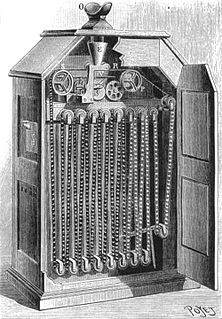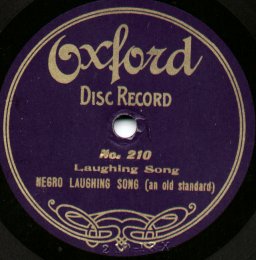
A phonograph, in its later forms also called a gramophone or since the 1940s called a record player, is a device for the mechanical recording and reproduction of sound. The sound vibration waveforms are recorded as corresponding physical deviations of a spiral groove engraved, etched, incised, or impressed into the surface of a rotating cylinder or disc, called a "record". To recreate the sound, the surface is similarly rotated while a playback stylus traces the groove and is therefore vibrated by it, very faintly reproducing the recorded sound. In early acoustic phonographs, the stylus vibrated a diaphragm which produced sound waves which were coupled to the open air through a flaring horn, or directly to the listener's ears through stethoscope-type earphones.

Celluloids are a class of compounds created from nitrocellulose and camphor, with added dyes and other agents. Generally considered the first thermoplastic, it was first created as Parkesine in 1856 and as Xylonite in 1869, before being registered as Celluloid in 1870. Celluloid is easily molded and shaped, and it was first widely used as an ivory replacement.

Phonograph cylinders are the earliest commercial medium for recording and reproducing sound. Commonly known simply as "records" in their era of greatest popularity, these hollow cylindrical objects have an audio recording engraved on the outside surface, which can be reproduced when they are played on a mechanical cylinder phonograph. In the 1910s, the competing disc record system triumphed in the marketplace to become the dominant commercial audio medium.

The Kinetoscope is an early motion picture exhibition device. The Kinetoscope was designed for films to be viewed by one individual at a time through a peephole viewer window at the top of the device. The Kinetoscope was not a movie projector, but introduced the basic approach that would become the standard for all cinematic projection before the advent of video, by creating the illusion of movement by conveying a strip of perforated film bearing sequential images over a light source with a high-speed shutter. A process using roll film was first described in a patent application submitted in France and the U.S. by French inventor Louis Le Prince. The concept was also used by U.S. inventor Thomas Edison in 1889, and subsequently developed by his employee William Kennedy Laurie Dickson between 1889 and 1892. Dickson and his team at the Edison lab also devised the Kinetograph, an innovative motion picture camera with rapid intermittent, or stop-and-go, film movement, to photograph movies for in-house experiments and, eventually, commercial Kinetoscope presentations.

The Columbia Graphophone Company Limited was one of the earliest gramophone companies in the United Kingdom.
The Gramophone Company Limited , based in the United Kingdom and founded on behalf of Emil Berliner, was one of the early recording companies, the parent organisation for the His Master's Voice (HMV) label, and the European affiliate of the American Victor Talking Machine Company. Although the company merged with the Columbia Graphophone Company in 1931 to form Electric and Musical Industries Limited (EMI), its name "The Gramophone Company Limited" continued in the UK into the 1970s.

The American Record Company was an American record label that was in business from 1904 to 1906.

Pathé Records was an international record company and label and producer of phonographs, based in France, and active from the 1890s through the 1930s.

Edison Records was one of the earliest record labels which pioneered sound recording and reproduction and was an important player in the early recording industry.

Blue Amberol Records was the trademark name for cylinder records manufactured by Thomas A. Edison, Inc. in the US from 1912 to 1929. They replaced the 4-minute black wax Amberol cylinders introduced in 1908, which had replaced the 2-minute wax cylinders that had been the standard format since the late 1880s. Blue Amberols can play for as long as 4 minutes and 45 seconds and have a surface layer of the "indestructible" plastic celluloid, which Edison tinted a trademark blue color. Edison brand phonographs designed to play Amberol cylinders were named Amberolas.

Oxford Records was a record label active in the United States of America from roughly 1906 until 1916. The label was produced for Sears by several labels, including Columbia and Albany Indestructible Cylinders for cylinders and Leeds & Catlin, Zon-O-Phone, and Columbia for discs. No recording activity was undertaken by Sears. All discs were single-sided. As with the previous Sears Harvard label, all Oxford labels were 'anonymous', not crediting the performing artists.

The Winner Records was a United Kingdom-based record label from 1912 onwards. Its records were manufactured by the Edison Bell Record Works, London. This company, founded by James Hough, had originated in the early 1890s as an importer of Edison and Columbia cylinder phonographs; from 1898 Hough had also made cylinder records, initially using a separate company, Edisonia. When Edison set up his own European operation in 1904, the import franchise was withdrawn, but the name Edison Bell remained in use. From 1909 the official name of Edison-Bell was J. E. Hough Ltd.
"The Teddy Bears' Picnic" is a song consisting of a melody by American composer John Walter Bratton, written in 1907, and lyrics added by Irish songwriter Jimmy Kennedy in 1932. It remains popular as a children's song, having been recorded by numerous artists over the decades. Kennedy lived at Staplegrove Elm and is buried in Staplegrove Church, Taunton, Somerset, England. Local folklore has it that the small wooded area between the church and Staplegrove Scout Hut was the inspiration for his lyrics.

The Graphophone was the name and trademark of an improved version of the phonograph. It was invented at the Volta Laboratory established by Alexander Graham Bell in Washington, D.C., United States.

Ernest George Pike was an English tenor of the early 20th century. After studying at the Guildhall School of Music in London, he worked as a bank clerk and sang as a church tenor before making his first recording "Take a Pair of Sparkling Eyes" for the Gramophone & Typewriter Company in 1904. He became the house tenor for HMV and made several hundred records in a career that spanned over twenty years.
Crystalate is an early plastic, a formulation of nitrocellulose, camphor, and alcohol invented in the late 19th century and patented by American inventor George Henry Burt. It is best known as a material for gramophone records produced in the UK by Crystalate Manufacturing Company, and for moulded billiards, pool and snooker balls, as produced by the Endolithic Company.

Albert Charles Campbell was an American popular music singer who recorded between the late 1890s and the 1920s. He was best known for his many duo recordings with Henry Burr, and as a member of the Peerless Quartet and other vocal groups, but also recorded successfully as a solo singer both under his own name and under various pseudonyms including Frank Howard.

Harry Anthony (1870–1954) was an American tenor and pioneer recording artist. With James F. Harrison he made several recordings of religious music that were popular at the time. He was known as a solo artist, and also became a member of the American Quartet. He made records for most of the major recording companies of the day.
Edison Bell was an English company that was the first distributor and an early manufacturer of gramophones and gramophone records. The company survived through several incarnations, becoming a top producer of budget records in England through the early 1930s until, after it was absorbed by Decca in 1932, production of various Edison Bell labels ceased.

Joseph Tunnicliffe Pope, Jr., known professionally as Murray K. Hill was an American vaudeville comic and recording artist active from the 1900s-1920s.

















